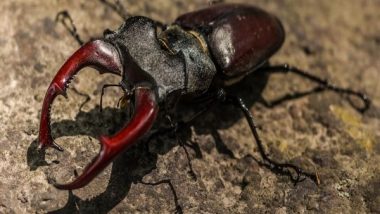Los Angeles [US], December 25 (ANI): A species of lined flat bark beetle larvae (Laemophloeus biguttatus) exhibit the previously unrecorded behaviour. In particular, the larvae have the ability to leap into the air, twisting themselves into loops as they do so. These leaps are special because of how the larvae accomplish it.
A group of scientists from North Carolina State University uncovered a jumping habit for insect larvae, and there is evidence that it occurs in a variety of species that haven't detected it yet.
"Jumping at all is exceedingly rare in the larvae of beetle species, and the mechanism they use to execute their leaps is - as far as we can tell - previously unrecorded in any insect larvae," says Matt Bertone, corresponding author of a paper on the discovery and director of North Carolina State University's Plant Disease and Insect Clinic.
While there are other insect species that are capable of making prodigious leaps, they rely on something called a "latch-mediated spring actuation mechanism." This means that they essentially have two parts of their body latch onto each other while the insect exerts force, building up a significant amount of energy. The insect then unlatches the two parts, releasing all of that energy at once, allowing it to spring off the ground.
Also Read | Christmas 2022: Quarrel Between Priests Leaves Kerala Cathedral Deserted on Xmas Eve.
"What makes the L. biguttatus so remarkable is that it makes these leaps without latching two parts of its body together," Bertone says. "Instead, it uses claws on its legs to grip the ground while it builds up that potential energy - and once those claws release their hold on the ground, that potential energy is converted into kinetic energy, launching it skyward."
The discovery of the behaviour was somewhat serendipitous. Bertone had collected a variety of insect samples from a rotting tree near his lab in order to photograph them when he noticed that these beetle larvae appeared to be hopping.
Bertone and paper co-author Adrian Smith then decided to film the behaviour in order to get a better look at what was going on. That's when they began to understand just how peculiar the behaviour was. Smith is a research assistant professor of biological sciences at NC State and head of the Evolutionary Biology & Behavior Research Lab at the North Carolina Museum of Natural Sciences.
"The way these larvae were jumping was impressive at first, but we didn't immediately understand how unique it was," Bertone says. "We then shared it with a number of beetle experts around the country, and none of them had seen the jumping behaviour before. That's when we realized we needed to take a closer look at just how the larvae was doing what it was doing."
To determine how L. biguttatus was able to execute its acrobatics, the researchers filmed the jumps at speeds of up to 60,000 frames per second. This allowed them to capture all of the external movements associated with the jumps, and suggested that the legs were essentially creating a latching mechanism with the ground.
The researchers also conducted a muscle mass assessment to determine whether it was possible for the larvae to make their leaps using just their muscles, as opposed to using a latch mechanism to store energy. They found that the larvae lacked sufficient muscle to hurl themselves into the air as far or as fast as they had been filmed jumping. Ergo, latching onto the ground was the only way the larvae could pull off their aerial feats.
Meanwhile, in an unrelated video about jumping maggots, Smith had included a short clip of the jumping behaviour in L. biguttatus. That video was seen by a researcher in Japan named Takahiro Yoshida, who had witnessed similar jumps in the larvae of another beetle species called Placonotus testaceus, but had not published anything related to the behaviour.
"We don't have high-speed footage of P. testaceus, but the video evidence we do have from Yoshida's lab suggests that this previously unknown behaviour is found in two different genera which are not even closely related," Bertone says.
"This raises a lot of questions. Has this behaviour evolved separately? Is it found in other beetle species? Are these genera more closely related than we previously suspected? There's a lot of interesting work to be done here." (ANI)
(This is an unedited and auto-generated story from Syndicated News feed, LatestLY Staff may not have modified or edited the content body)













 Quickly
Quickly
















